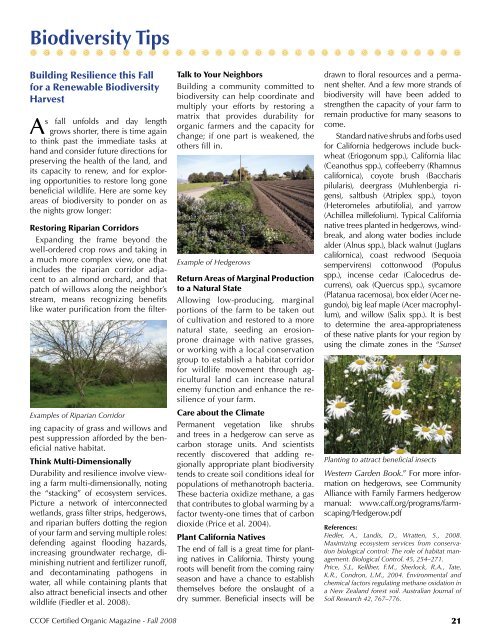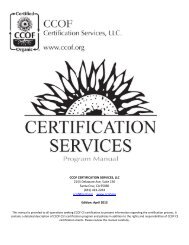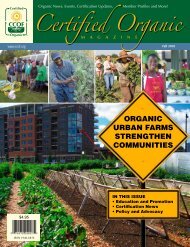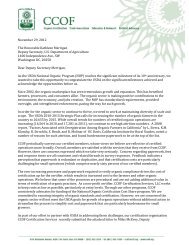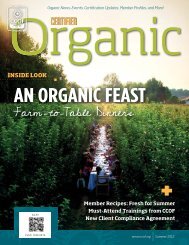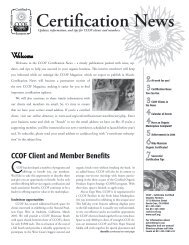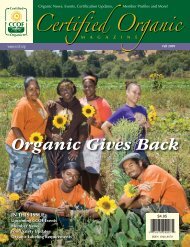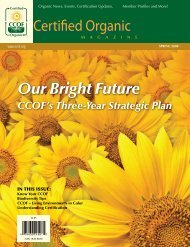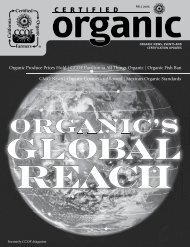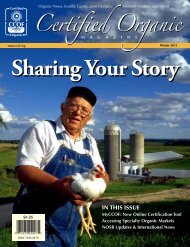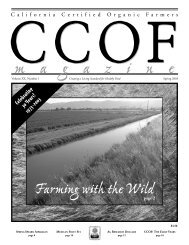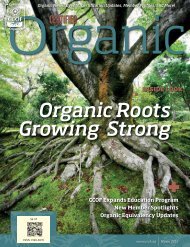Create successful ePaper yourself
Turn your PDF publications into a flip-book with our unique Google optimized e-Paper software.
Biodiversity TipsBuilding Resilience this Fallfor a Renewable BiodiversityHarvestAs fall unfolds <strong>and</strong> day lengthgrows shorter, there is time againto think past the immediate tasks ath<strong>and</strong> <strong>and</strong> consider future directions forpreserving the health of the l<strong>and</strong>, <strong>and</strong>its capacity to renew, <strong>and</strong> for exploringopportunities to restore long gonebeneficial wildlife. Here are some keyareas of biodiversity to ponder on asthe nights grow longer:Restoring Riparian CorridorsExp<strong>and</strong>ing the frame beyond thewell-ordered crop rows <strong>and</strong> taking ina much more complex view, one thatincludes the riparian corridor adjacentto an almond orchard, <strong>and</strong> thatpatch of willows along the neighbor’sstream, means recognizing benefitslike water purification from the filter-Examples of Riparian Corridoring capacity of grass <strong>and</strong> willows <strong>and</strong>pest suppression afforded by the beneficialnative habitat.Think Multi-DimensionallyDurability <strong>and</strong> resilience involve viewinga farm multi-dimensionally, notingthe “stacking” of ecosystem services.Picture a network of interconnectedwetl<strong>and</strong>s, grass filter strips, hedgerows,<strong>and</strong> riparian buffers dotting the regionof your farm <strong>and</strong> serving multiple roles:defending against flooding hazards,increasing groundwater recharge, diminishingnutrient <strong>and</strong> fertilizer runoff,<strong>and</strong> decontaminating pathogens inwater, all while containing plants thatalso attract beneficial insects <strong>and</strong> otherwildlife (Fiedler et al. 2008).Talk to Your NeighborsBuilding a community committed tobiodiversity can help coordinate <strong>and</strong>multiply your efforts by restoring amatrix that provides durability fororganic farmers <strong>and</strong> the capacity forchange; if one part is weakened, theothers fill in.Example of HedgerowsReturn Areas of Marginal Productionto a Natural StateAllowing low-producing, marginalportions of the farm to be taken outof cultivation <strong>and</strong> restored to a morenatural state, seeding an erosionpronedrainage with native grasses,or working with a local conservationgroup to establish a habitat corridorfor wildlife movement through agriculturall<strong>and</strong> can increase naturalenemy function <strong>and</strong> enhance the resilienceof your farm.Care about the ClimatePermanent vegetation like shrubs<strong>and</strong> trees in a hedgerow can serve ascarbon storage units. And scientistsrecently discovered that adding regionallyappropriate plant biodiversitytends to create soil conditions ideal forpopulations of methanotroph bacteria.These bacteria oxidize methane, a gasthat contributes to global warming by afactor twenty-one times that of carbondioxide (Price et al. 2004).Plant California NativesThe end of fall is a great time for plantingnatives in California. Thirsty youngroots will benefit from the coming rainyseason <strong>and</strong> have a chance to establishthemselves before the onslaught of adry summer. Beneficial insects will bedrawn to floral resources <strong>and</strong> a permanentshelter. And a few more str<strong>and</strong>s ofbiodiversity will have been added tostrengthen the capacity of your farm toremain productive for many seasons tocome.St<strong>and</strong>ard native shrubs <strong>and</strong> forbs usedfor California hedgerows include buckwheat(Eriogonum spp.), California lilac(Ceanothus spp.), coffeeberry (Rhamnuscalifornica), coyote brush (Baccharispilularis), deergrass (Muhlenbergia rigens),saltbush (Atriplex spp.), toyon(Heteromeles arbutifolia), <strong>and</strong> yarrow(Achillea millefolium). Typical Californianative trees planted in hedgerows, windbreak,<strong>and</strong> along water bodies includealder (Alnus spp.), black walnut (Juglanscalifornica), coast redwood (Sequoiasempervirens) cottonwood (Populusspp.), incense cedar (Calocedrus decurrens),oak (Quercus spp.), sycamore(Platanua racemosa), box elder (Acer negundo),big leaf maple (Acer macrophyllum),<strong>and</strong> willow (Salix spp.). It is bestto determine the area-appropriatenessof these native plants for your region byusing the climate zones in the “SunsetPlanting to attract beneficial insectsWestern Garden Book.” For more informationon hedgerows, see CommunityAlliance with Family Farmers hedgerowmanual: www.caff.org/programs/farmscaping/Hedgerow.pdfReferences:Fiedler, A., L<strong>and</strong>is, D., Wratten, S., 2008.Maximizing ecosystem services from conservationbiological control: The role of habitat management.Biological Control. 45, 254–271.Price, S.J., Kelliher, F.M., Sherlock, R.A., Tate,K.R., Condron, L.M., 2004. Environmental <strong>and</strong>chemical factors regulating methane oxidation ina New Zeal<strong>and</strong> forest soil. Australian Journal ofSoil Research 42, 767–776.<strong>CCOF</strong> Certified <strong>Organic</strong> Magazine - Fall 200821


